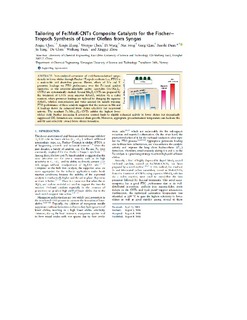| dc.contributor.author | Chen, Bingxu | |
| dc.contributor.author | Zhang, Xinxin | |
| dc.contributor.author | Wenyao, Chen | |
| dc.contributor.author | Wang, Di | |
| dc.contributor.author | Song, Nan | |
| dc.contributor.author | Qian, Gang | |
| dc.contributor.author | Duan, Xuezhi | |
| dc.contributor.author | Yang, Jia | |
| dc.contributor.author | Chen, De | |
| dc.contributor.author | Yuan, Wei-kang | |
| dc.contributor.author | Zhou, Xinggui | |
| dc.date.accessioned | 2019-03-04T15:46:01Z | |
| dc.date.available | 2019-03-04T15:46:01Z | |
| dc.date.created | 2018-12-15T17:40:22Z | |
| dc.date.issued | 2018 | |
| dc.identifier.citation | Industrial & Engineering Chemistry Research. 2018, 57 (34), 11554-11560. | nb_NO |
| dc.identifier.issn | 0888-5885 | |
| dc.identifier.uri | http://hdl.handle.net/11250/2588584 | |
| dc.description.abstract | Iron-catalyzed conversion of coal/biomass-derived syngas directly to lower olefins through Fischer–Tropsch synthesis (i.e., FTO) is a sustainable and short-flow process. Herein, effects of Mn and K promoter loadings on FTO performance over the Fe-based catalyst supported on the promoter-adjustable carbon nanotubes (Fe/MnxKy-CNTs) are systematically studied. Several MnxKy-CNTs are prepared by the treatment of CNTs using aqueous KMnO4 solution via a redox reaction, where promoter loadings are tailored by changing the aqueous KMnO4 solution concentration and water amount for sample washing. FTO performance of these catalysts suggests that the increase in Mn and K loadings shows the enhanced lower olefins selectivity but suppressed activity. The resultant Fe/Mn16.5K1.2-CNTs exhibit the highest lower olefins yield. Further increasing K promoter content leads to slightly enhanced activity to lower olefins but dramatically suppressed CH4 formation and enhanced chain growth. Moreover, appropriate precarburization temperature can facilitate the activity and selectivity toward lower olefins formation. | nb_NO |
| dc.language.iso | eng | nb_NO |
| dc.publisher | American Chemical Society | nb_NO |
| dc.title | Tailoring of Fe/MnK-CNTs Composite Catalysts for the Fischer–Tropsch Synthesis of Lower Olefins from Syngas | nb_NO |
| dc.type | Journal article | nb_NO |
| dc.type | Peer reviewed | nb_NO |
| dc.description.version | acceptedVersion | nb_NO |
| dc.source.pagenumber | 11554-11560 | nb_NO |
| dc.source.volume | 57 | nb_NO |
| dc.source.journal | Industrial & Engineering Chemistry Research | nb_NO |
| dc.source.issue | 34 | nb_NO |
| dc.identifier.doi | 10.1021/acs.iecr.8b01795 | |
| dc.identifier.cristin | 1643684 | |
| dc.description.localcode | © American Chemical Society 2018. This is the authors accepted and refereed manuscript to the article. Locked until 09.08.2019 due to copyright restrictions. | nb_NO |
| cristin.unitcode | 194,66,30,0 | |
| cristin.unitname | Institutt for kjemisk prosessteknologi | |
| cristin.ispublished | true | |
| cristin.fulltext | postprint | |
| cristin.qualitycode | 2 | |
